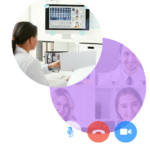Postoperative Patients: Virtual Care with Remote Monitoring Reduces Pain
Introduction
The postoperative period is a critical phase in a patient’s recovery, where effective pain management and continuous monitoring are essential to prevent complications and accelerate healing. In recent years, virtual care combined with Remote Patient Monitoring (RPM) has emerged as a powerful tool for improving postoperative care and reducing pain for patients recovering from surgery.
The Role of Remote Monitoring in Postoperative Care
Remote monitoring allows healthcare providers to track vital signs, such as heart rate, blood pressure, and body temperature, as well as other key patient data from a distance. For postoperative patients, this means they can remain in the comfort of their own homes while still receiving the close monitoring they would typically need in a hospital setting. This constant surveillance helps to quickly identify any signs of complications, allowing for timely interventions that can prevent further health issues.
Reducing Pain Through Virtual Care
One of the significant benefits of virtual care with RPM is its ability to help manage and reduce postoperative pain more effectively. Here’s how:
- Real-Time Pain Management: Patients can report their pain levels through connected devices or apps, allowing healthcare providers to adjust pain management strategies in real-time. This ensures that patients receive the appropriate pain relief as needed, rather than waiting until their next in-person visit.
- Personalized Treatment Adjustments: Remote monitoring provides continuous data that can be analyzed to tailor pain management plans specifically to each patient’s needs. For instance, if a patient’s pain is not adequately controlled, healthcare providers can modify medication dosages or suggest alternative therapies based on real-time feedback.
- Patient Empowerment and Engagement: By involving patients in their own care through RPM, they become more engaged in managing their pain. Patients can monitor their progress, see how certain activities or medications affect their pain levels, and communicate directly with their healthcare team to make adjustments.
- Early Detection of Complications: Effective pain management is closely linked to overall recovery. If pain is not controlled, it can lead to complications such as poor wound healing or even chronic pain. Remote monitoring allows for the early detection of potential issues, such as infections or blood clots, that could exacerbate pain and hinder recovery.
Benefits of Virtual Care for Postoperative Patients
The integration of virtual care and RPM into postoperative care routines offers numerous advantages:
- Reduced Hospital Readmissions: By closely monitoring patients at home, healthcare providers can identify issues before they require hospital readmission, which not only reduces healthcare costs but also lessens the burden on patients.
- Improved Patient Satisfaction: Patients often prefer recovering at home, where they feel more comfortable and less stressed. Virtual care enables this while still providing the necessary medical oversight.
- Enhanced Recovery Times: With more consistent pain management and early intervention in case of complications, patients are likely to experience quicker recovery times and better overall outcomes.
Conclusion
Virtual care, combined with remote monitoring, is transforming the landscape of postoperative care. By providing continuous monitoring, personalized pain management, and a more comfortable recovery environment, these technologies help to reduce pain and improve the overall recovery experience for postoperative patients. As healthcare continues to evolve, the adoption of such innovative approaches is likely to become a standard part of postoperative care, ensuring better outcomes and higher patient satisfaction.



